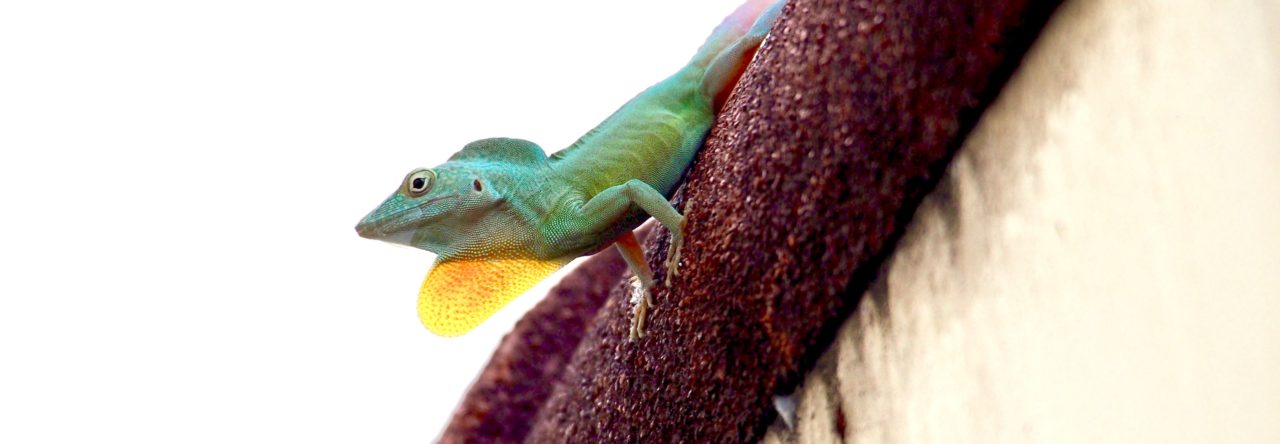Yet another newspaper article on brown anoles supplanting green anoles. This one from The Times of Apalachicola and Carabelle in Florida. The text of the article is reprinted below, but it contains maps and other figures that you’ll have to go to the original to see. Also, the article included the video above.
Cuban anoles at war with native Carolinians
The Forgotten Coast is being invaded by an exotic lizard called the Cuban brown anole. This may not be a crisis unless you are a native green anole, in which case, raise the alarm because the newly-arrived brown anoles really are eating your young. And once invasive brown anoles are established, there is no way of removing them.
For the past 10 years, most of the anoles in local yards were the little green natives called Carolina anoles. They are not true chameleons, but some people call them that because they can change their color from brown to green. As every child knows, the males climb up tree trunks and flower stems and flash their rosy pink throat pouches, called dewlaps, to let females know they are interested.
But this year, green anoles have become scarce. Most of the anoles in my yard are now brown to black, with a light stripe down the back, and their throat pouch is bright orange rather than pink. Some of the males also have a raised crest from head to tail like a mini-dragon. Unlike Carolina anoles, brown anoles cannot change color, so no one will mistake them for chameleons.
When brown anoles appear, green anoles take to the treetops and become scarcer. Green anoles also adapt to their new situation by becoming even better tree climbers. Scientists have shown that the foot pads on green anoles become larger over time when brown anoles force them into tree canopies. This change is said to be a case of rapid genetic adaptation going on before our eyes.
Naturally, two similar species that are competing for food and territory will fight each other. Island resident Kimberly Alexis recently took a video of green and brown anoles fighting on a fence in her yard. Although the green lizard attacked the brown one, the brown anole quickly got a good bite on the green anole’s head. It surely would have won the contest if Kimberly had not broken up the fight. (See photo)
At first, I thought the brown anoles were merely green ones changing their color. Then a friend said, no, it is actually a different species that is creating havoc among the local lizards. It turns out that we humans accidentally imported the lizards with cargo coming from Cuba and the Bahama Islands. The brown anole first arrived on a ship that was unloaded on the Florida peninsula or the Keys around 1887 and began spreading north, (See map)
A map from 2004 that depicts the distribution of brown anoles does not show them in the Florida Panhandle, but not only are they in Franklin County, they are already on the barrier islands. Clearly, their range is expanding. How a land-loving lizard got to the barrier islands is anybody’s guess. One possibility is that they arrived as eggs in the roots of potted house plants.
Like a lot of other lizards in Florida, brown anoles are also kept as pets, and some of the feral population probably escaped into the wild. The Florida Fish and Wildlife Conservation Commission compiled a list of non-native reptiles that are now established in Florida, and they list 20 kinds of exotic anoles and their relatives that now live here.
The brown anole is hardly alone. Over 170 different reptiles have been introduced into Florida from imported cargo, from release of pets, or from zoos and research facilities after hurricanes. FWC lists 54 exotic reptiles that now have established breeding populations in the state, meaning that they have been present for 10 years. For example, Alexis mentioned that she also finds Mediterranean house geckos in her yard. Like most lizards, house geckos were brought here as pets but escaped and quickly became established.
The best known and most destructive escaped reptile in Florida is the Burmese python, which eats any native bird, mammal or even alligator it can wrap its coils around. Except for humans, mature alligators are the only animal large enough to return the favor and eat pythons.
I may be the last person in Franklin County to have noticed brown anoles, partly because there are many kinds of small lizards in the county. We have blue-tailed skinks, red skinks, Mediterranean house geckos, and legless Eastern glass lizards that many people mistake for snakes. Glass lizards have a checkered diamond pattern on their body that makes them look like a men’s tie, so my wife calls them “menswear lizards.”
From the standpoint of homeowners and gardeners, brown anoles are beneficial. Although they do eat the eggs of green anoles, they also eat flying insects, grasshoppers, spiders and even cockroaches. One can only hope that they will also dine on gnats and mosquitoes!
James Hargrove, a retired university professor who now lives on St. George Island, is a regular contributor to the Times on subjects of history and science. He can be reached at jhargrov@gmail.com
- Evolution in Real Time on Lizard Island - March 23, 2025
- Spider Snags Adult Anolis osa - March 22, 2025
- An Homage to the Green Anoles of New Orleans - March 21, 2025


Laura Jones
Quite interesting how far they have gotten. I have seen them in Macon, of all other places now here in GA. Our winters get too cold, but some nights are mild/ cool so who knows how/if they’ll adapt.
The green anoles hopefully will find a way to adapt…